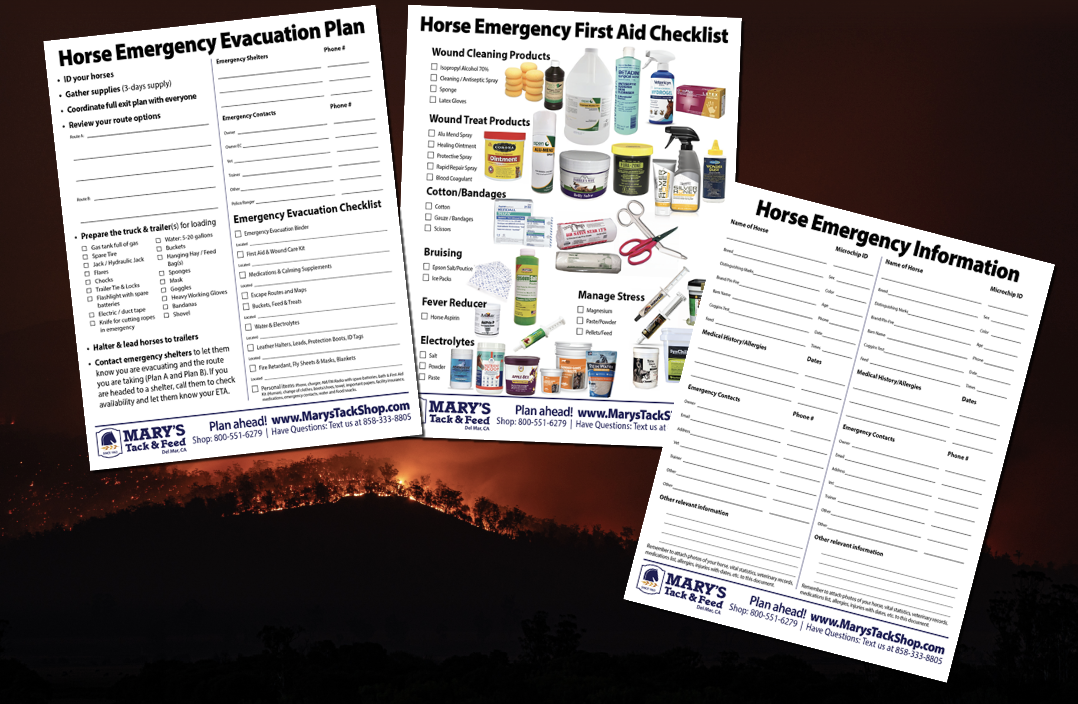Preparing an Equine Emergency Evacuation Plan
Posted by Mary's Tack & Feed on 22nd Aug 2023

Preparing an equine emergency evacuation plan ahead of time is necessary to keep your horses safe during fires or other emergencies or disasters. Mary’s Tack and Feed has put together an Equine Emergency Evacuation List along with other important information.
It’s best to prepare now for several different evacuation situations. The scenarios can be based on where you keep your horses and pets, disasters that have hit your area in the past, and changes to the climate and surrounding landscape that could affect you and your horses directly.
Emergency Horse Evacuation Plan – An Overview
- Horse Identification Information
- Equine Emergency Contacts List
- Emergency Evacuation Checklist
- Horse Trailer Checks and Checklist
- Horse Emergency Evacuation Plan
- Rehearsal / Fire Drill for Horses
- Backup sources for any additional trailers and support teams
- Laminated copies of your Evacuation Plan
DOWNLOAD CHECKLIST & PAPERWORK
Horse Evacuation Identification Information
First, make sure each animal you own has identifiable information (microchips, tattoos, brands, etc.) and that you’ve recorded all of their vital statistics like age, breed, name, sex and markings.
Next, ensure that you’ve stored your horses’ identification documents with photos in a safe place and have digital backups of these documents. Inform trusted neighbors or people you’ll rely on in times of emergency where they can access these documents.
Include your horses’ veterinary records with pertinent medical conditions like allergies, injuries, medications and list multiple contact numbers and emails for you and others responsible for your animals’ well-being. Again, have physical and digital copies (online, flash drives, etc.) of these records stored in secure, waterproof areas and folders.
You can attach horse identification tags to halters or manes with emergency information as well. Also, consider using EquestiSafe Horse Identification Collars to provide your horses with an additional level of emergency identification security during an emergency evacuation.
At each stall or in a central location, have ID tags or collars ready with lead ropes and other emergency kits prepped and ready to place in the trailer. (See Emergency Preparedness for Horses for full list of items to have on the ready.)
Equine Emergency Contact List
- County emergency horse shelters / locations to keep horses safe
- Owner name, phone numbers, emails and home addresses
- Veterinary: Regular one that knows the horse as well as a backup one
- Rescue units and equine support groups in your area
- Horse feed and supplies shops in your county and neighboring counties
- Trainers and other support personnel
- Relative of owner in case something happens to the owner
Emergency Horse Evacuation Checklist
- Binder with collected information (Horse ID, Emergency Contacts and Phone Numbers, List of Shelters and Support People, photos, horse information, medications list, Insurance information, etc)
- First Aid Kit, Wound Care, Calming Supplements
- Escape Routes and Maps
- Buckets, Feed, Water, Electrolytes, Treats and where they are stored
- Leather Halters, Leads, Protection Boots, ID Tags
- Fire Retardant, Fly Sheets & Masks, Blankets
- Personal items: Bath & First Aid Kit (Human), Change of cloth, boots/shoes, towel, important papers, facility insurance, medications, emergency contact, water and food/snacks. Masks, goggles, heavy working gloves and bandanas.
Horse Trailer Checks and Horse Trailer Checklist
Your trailer(s) need to be ready to pull out, load and go. Frequently check the tires, locks, supplies and hitch to be sure everything is in good working condition so there are no issues when it’s time to go.
Horse Trailer Checklist for Emergency Evacuation
- Spare Tire
- Jack / Hydraulic Jack
- Flares
- Chocks
- Trailer Tie & Locks
- Flashlight with spare batteries
- Electric tape / duct tape
- Knife for cutting ropes in emergency
- Water: 5-20 gallons
- Buckets
- Hanging Hay / Feed Bag(s)
- Sponges
- Mask
- Goggles
- Heavy Working Gloves
- Bandanas
- Shovel
See all trailer accessories: https://marystack.com/care-and-stable/stable-supplies/trailer-accessories/
Horse Emergency Evacuation Plan – Practices This with a Timer
- ID your horses with your phone number if they don’t have a microchip. Use a sharpie on hoofs or Shapley’s Touch Up Coat Spray.
- Gather supplies: First-aid kits, water, food, medications, bedding, blankets (3-days supply is recommended)
- Coordinate full exit plan with all involved, especially if you have to do 2 or more trips to evacuate all your horses
- Review your route options
- Prepare the trailer(s) for loading
- Halter & lead horses to trailers
- Contact emergency numbers to let them know you are evacuating and the route you are taking (Plan A and Plan B). If you are headed to a shelter, call them to check availability and let them know your ETA.
Rehearse Your Equine Emergency Evacuation Plan – Fire Drill with Your Horses
Rehearse your equine emergency evacuation plan(s) based on the most likely disaster scenarios you'll have to contend with. Practice quickly and safely loading your animal onto a trailer in daytime and nighttime and various weather conditions.
If a neighbor or animal-care service is going to
trailer your horses, involve them in your practice runs as well. Make sure third parties know where they can access emergency horse supplies and contact information.
Prep several locations where you can release your horses if unable to properly evacuate them farther away. For example, a spot away from trees and near a body of water during a fire (i.e. an enclosed area that has been tamped down and is out of the line of fire). Check with local authorities about possible emergency shelters in your region and include these locales in your watertight emergency binders or folders.
Keep and provide copies of your horse evacuation plans and back-up plans for yourself and others whom you might have to rely on. Update these plans as needed and make sure your friends and neighbors are updated as well.
Backup sources for any additional trailers and support teams
You may not be at your facility when a disaster or emergency evacuation happens. Having a plan and everything prepared for easy access and gathering is critical in these situations. We’ve collected this information and checklist on a downloadable PDF so that you can post it in multiple areas at your facility.
Prepare or print out this emergency horse evacuation checklist. Personalize it with the emergency scenarios you’re likely to encounter. When it’s time to evacuate, people tend to move about frantically. A horse evacuation procedure will let you and the people helping you stay focused on each item you need to take care of.
Laminated Copies of Your Evacuation Plan - Distribution
Post your emergency plans and checklist in several locations around your property (offices, stables, entryways, etc.) to help emergency personnel or Good Samaritans on scene who might not be keyed into your plans.
By setting up your equine emergency plans and checklists now, along with rehearsing how to evacuate your animals, you’ll be ready to handle almost any crisis if and when the time comes.
Too much too fast - The last resort
If a wildfire’s proximity does not permit the time needed to load horses, it’s best to turn them loose. Remove all halters or anything that might get them stuck or unable to move. Do not leave them confined in a barn or pasture. Close the doors and gates so they can’t re-enter these areas.
Note: This is a very last resort. Read full article about horse and large animal evacuation plans from the LA County Emergency Management website.
Horses typically can handle most earthquakes but having them in an open area away from trees is ideal. What is important is for you to have an emergency plan for events that may follow large quakes such as dam breaks, storms, or fires.
Contact local law enforcement and ranger stations to let them know your horse is out and their last known location.
By setting up your emergency horse evacuation plans and checklists now, along with rehearsing how to evacuate your animals, you'll be ready to handle almost any crisis if and when the time comes.
OTHER ARTICLES & VIDEOS YOU MAY LIKE:
Ten Tips for Trailering Your Horse
How to Get Your Horse into a Trailer Videos

